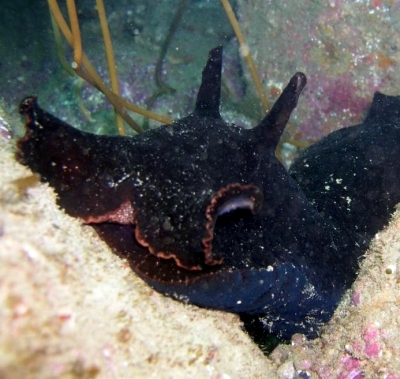
Aplysia vaccaria
Winkler, 1955
Order: ANASPIDEA
Superfamily: APLYSIOIDEA
Family: Aplysiidae
DISTRIBUTION
Morro Bay, California to Gulf of California.
PHOTO
Santa Catalina Island, 50 feet, California, USA, Pacific Ocean, 23 July 2006, Kelp Forest. Length: 60 - 70 cm. Photographer: Amber Purohit.
'Uniform dark brown to black body, sometimes with fine grey or white markings. feeds primarily on brown algae Egregia. The world's largest gastropod, it reaches 99cm in length and can weigh nearly 14kgs.' ... Behrens, D.W. (1981) Pacific Coast Nudibranchs.
Differs from other southern Californian species, Aplysia californica, in not producing purple ink (see Ron Velarde's message).
-
Winkler, L.R. (1955) A new species of Aplysia on the southern California coast. Bull. South. Calif. Acad. Sci. 54 (1): 5-7.
-
Winkler, L. R. & Dawson, E.Y. (1963) Observations and experiments on the food habits of California sea hares of the genus Aplysia. Pacific Science, 17 (1): 102-105.
Related messages
Re: Is this a sea slug? It's HUGE!!
December 30, 2006
From: John Sawitskas
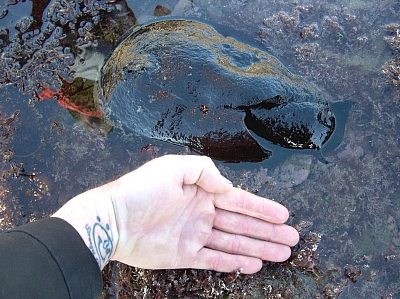
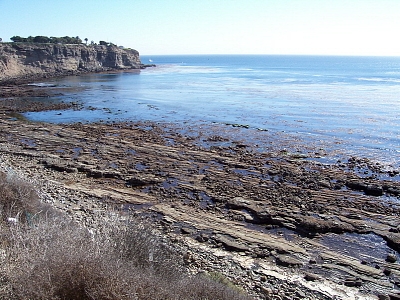
Concerning message #1666:
I've been looking at Sea Hares now for over a year and just Love them and seeing as I've never been Inked, I think they seem to like me too. I found this one on 12/3/06 in San Pedro, Ca. just off of Point Fermin. The tide was at a -1.3, This is by far the bestest I've seen, I would have to say 14 inches maybe more it's still balled up a bit, my foot is 12 in. I was wondering if I got lucky on this find or is that a somewhat common size for these?
Locality: San Pedro, 8 in. of sea, California, Pacific, 12/3/06, Found in Sea Grass. Length: 14-16in.. Photographer: John Sawitskas.
John Sawitskas
prnthead@earthlink.net
Sawitskas, J.R., 2006 (Dec 30) Re: Is this a sea slug? It's HUGE!!. [Message in] Sea Slug Forum. Australian Museum, Sydney. Available from http://www.seaslugforum.net/find/19064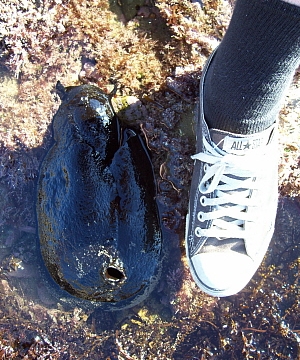
Hi Johnny,
This is the black seahare, Aplysia vaccaria. This species is characterized by a very firm body and that the parapodia are joined behind the exhalent siphon, rather than separated part of the way down the tail, as in the co-occurring species, Aplysia californica.
It is interesting that you mention that you have not been inked yet. Good observation. This is one of the few species along this coastline that does not produce a purple ink when disturbed.
You also mention that it was "huge." Imagine a specimen three times this long or more. I am told that this species is the largest gastropod in the world. Specimens reaching 99 cm and weighing nearly 14 kg, have been observed. Now thats huge.
Best wishes,
Dave Behrens
Re: Possible Aplysia vaccaria from Santa Catalina Island
August 1, 2006
From: Ernie Hartt
Concerning message #17246:
This specimen does indeed appear to be a typical A. vaccaria, as seen in the general Southern California area. I don't know of any other sea slugs in this area that reach that size.
They are very active and seemingly curious animals. I collected a medium sized (30 cm) specimen while I was doing my master's research (to use as a demonstration animal for a Biology lab), and was able to hand feed it Ulva, which it gulped down quite readily.
Ernie Hartt
United States
lumikko@snail-mail.net
Hartt, Ernest W, 2006 (Aug 1) Re: Possible Aplysia vaccaria from Santa Catalina Island. [Message in] Sea Slug Forum. Australian Museum, Sydney. Available from http://www.seaslugforum.net/find/17289Thanks Ernie,
Best wishes,
Bill Rudman
Possible Aplysia vaccaria from Santa Catalina Island
July 31, 2006
From: Amber Purohit
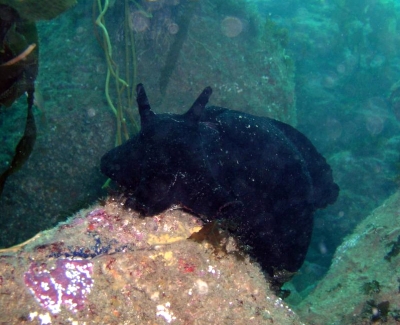
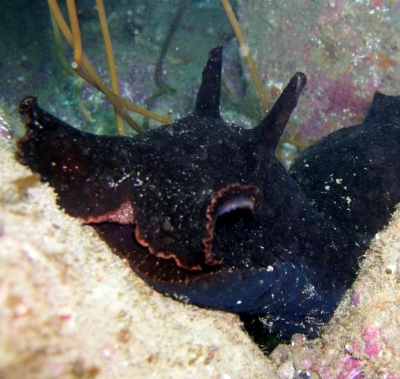
This weekend I had the great joy of stumbling across a giant sea hare while diving. I had never seen one this large. I estimate his length to be 60 - 70 cm. He was extremely active and curious. He lumbered around munching on kelp (see 1 of the 3 images) and even came right up to my camera to take a closer look at me. I stayed with him for about 30 minutes because I found him so fascinating. At first I thought he was Aplysia californica, but reading on your website I learned the only difference between A. californica and A. vaccaria is that A. californica produces purple ink when agitated. I know I startled him at least twice, and there was no ink release. This coupled with his extremely large size led me to believe it was indeed Aplysia vaccaria, but I welcome any insight you might have. What a wonderful joy though to spend just half an hour watching this uncoordinated and curious creature! I apologize for the particulate matter in the pictures, but he was particularly active, which led to lots of sediment in the photos.
Locality: Santa Catalina Island, 50 feet, California, USA, Pacific Ocean, 23 July 2006, Kelp Forest. Length: 60 - 70 cm. Photographer: Amber Purohit.
Amber Purohit
seaslugchick@verizon.net
Purohit, A.L., 2006 (Jul 31) Possible Aplysia vaccaria from Santa Catalina Island. [Message in] Sea Slug Forum. Australian Museum, Sydney. Available from http://www.seaslugforum.net/find/17246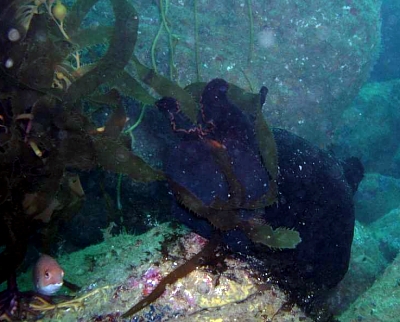
Dear Amber,
There is not a lot known about this species, but Behrens & Hermosillo (2005) report that it grows up to 99 cm in length, feeds primarily on the brown alga Egregia in kelp beds, and does not produce purple ink. They describe its colour as 'uniform dark brown to black ... sometimes with fine grey or white markings'.
I suspect you are correct in identifying your animal as A. vaccaria rather than A. californica, but would be grateful for feedback from local experts. Sea hares are sometimes difficult to identify from photos. If I can get a confirmation, I will at last have a photo of this species for the Fact Sheet
Best wishes,
Bill Rudman
